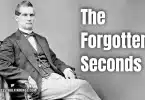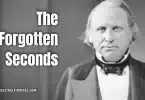Before the White House, before political parties fully took shape, and before America had even decided how it wanted to govern itself, there was George Clinton. He didn’t wear a powdered wig for fashion. He wore it through gun smoke and battle. A wartime general, a power-hungry governor, and one of the longest-serving public officials in early American history, Clinton seemed destined to be more than just a sidekick.
Yet despite holding the office of vice president under not one but two presidents, he never claimed the top job for himself. Why?
Was it age? Politics? Health? Or was it that Clinton didn’t want to play by the rules of a system he never fully trusted?
Born to the Edge of Empire
George Clinton was born July 26, 1739, in a frontier community called Little Britain in Ulster County, Province of New York. His early years were spent on the borderlands of British-controlled America, where the wilderness met civilization and land disputes were often settled with fists or firearms. His family had arrived in the colonies through Ireland, but their roots extended back even further—to the English gentry.
Clinton’s father, Charles Clinton (1690–1773), was born in County Longford, Ireland, but he wasn’t Irish in the traditional sense. The Clintons were Anglo-Irish Protestants, part of the so-called “Ascendancy” class—English settlers who governed and controlled Irish land during the colonial period. In 1729, Charles packed up his family and set sail aboard George and Anne to America. What should have been a new beginning turned tragic. The journey took over five months due to deliberate delays by the ship’s captain, who withheld rations to sell them at inflated prices. Over 90 passengers died, including two of Charles’s children.
But Charles Clinton survived, settled in New York, and rose to prominence. He became a judge, a militia colonel, and a community leader. His wife, Elizabeth Denniston, came from another Scots-Irish Presbyterian line—families that had been pushed from Scotland to Ireland before emigrating once more to America. George Clinton descended from a long tradition of Protestant independence and war-worn migration through both sides.
The Clinton family produced more than one leader. George’s older brother, James Clinton, became a Revolutionary War general. James’s son—George’s nephew—was DeWitt Clinton, who would later become a U.S. Senator, New York’s governor, and the driving force behind the Erie Canal.
From Surveyor to Soldier
Like many sons of prominent colonial families, George Clinton was educated at home and trained in practical trades. He studied surveying, law, and military science. By age 18, he served in the British colonial forces during the French and Indian War, where he fought in the 1758 expedition that captured Fort Frontenac in modern-day Canada.
After the war, Clinton turned to law and entered politics. By the late 1760s, he had become a rising voice in the New York General Assembly, opposing British taxation and aligning with early Patriots. Clinton was already preparing for a future outside British rule when the American colonies began inching toward rebellion.
In 1775, with war erupting, Clinton was appointed brigadier general in the Continental Army. He played a key role in defending the Hudson River Valley—a vital corridor for the American cause. Though not a household name among Revolutionary generals, Clinton’s strategic mind and local leadership made him indispensable in New York.
Governor for Life
In 1777, as New York adopted its first state constitution, George Clinton was elected the first governor under the new system. His hold on the office would become legendary. He served from 1777 to 1795, and again from 1801 to 1804. That’s 21 years—still the longest tenure of any governor in New York’s history.
Clinton was fiercely independent and firmly believed in state sovereignty. He opposed the concentration of power in a national government and viewed federalists like Alexander Hamilton with suspicion. When the U.S. Constitution was proposed in 1787, Clinton opposed its ratification, arguing it gave too much power to the federal center at the expense of the states.
His popularity in New York made him nearly untouchable. He greatly influenced land policies, judicial appointments, and infrastructure development. But with that power came criticism. Detractors accused him of consolidating control through patronage and political favors. New York under Clinton was not just a state; it was his political fortress.
Vice President—Twice
In 1804, Clinton was selected as Thomas Jefferson’s running mate for a second term. The choice was calculated. Jefferson needed a loyalist from the North to replace the scandal-ridden Aaron Burr. Clinton fit the bill. A Revolutionary War hero, a seasoned statesman, and a staunch anti-Federalist, he brought balance to the ticket.
At 65, Clinton was the oldest man ever elected vice president at that time. He presided over the Senate but rarely involved himself in the daily affairs of Jefferson’s administration. He was known for opposing many of Jefferson’s national projects, including expanding federal banking power.
When Jefferson declined to seek a third term, Clinton eyed the presidency. But James Madison had the inside track. Clinton’s health was failing, and his political support beyond New York was thin. Still, he ran as Madison’s vice president in 1808 and won, becoming the first vice president to serve under two different presidents.
Clinton died in office on April 20, 1812, at age 72. He was the first vice president to die while serving and one of the few who held the job for more than one term.
The Clinton Legacy: Complex and Lasting
George Clinton left behind more than a resume. He left a legacy of independence and caution—a reminder that some of the founding generation were deeply skeptical of unchecked federal authority. His refusal to support the Constitution, while seen as regressive by some, stemmed from a deep concern over individual and state rights.
He was a loyal servant of New York and an early champion of frontier Americans, but also a man who clung to power and resisted compromise. While he did not speak out against slavery, he did not champion it either. Like many early leaders, his silence on the issue leaves questions about where he truly stood.
Towns, counties, and even schools still bear his name. Clinton County, New York. Clinton, Mississippi. Clinton, Iowa. His family line influenced American politics for generations through DeWitt Clinton and beyond.
George Clinton never became president, but didn’t need to for much of the Revolutionary and early national periods. He was already the most powerful man in the room in his corner of the republic and liked it that way.
He rests now in Kingston, New York. Not in Washington, not in the Capitol, but in the state he fought so hard to protect.






